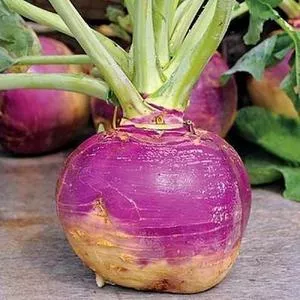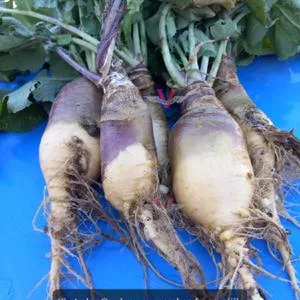Rutabaga / Swedes
Brassica napus, Napobrassica Group
Rutabagas, also known as Swede turnips or simply Swedes, are an often overlooked table vegetable in our modern western diet. They appeared in Europe in the Middle Ages and are reportedly the result of a stabilized cross between cabbage and turnips. They were once extensively grown for animal fodder on most farms, but also were appreciated as a table vegetable.
The roots are close-grained, very hard, and except in areas of extreme cold, generally endure a considerable degree of cold without injury. In regions receiving mild winters and well-drained soil, they can be left in the ground over winter and lifted as needed. In harsher location, they can be stored in cellars during the winter months and typically remain in excellent condition into early spring.
Rutabagas can be added to soups and stews, made into "fries," or used in casseroles. For those on low starch diets, rutabagas can be boiled, mashed, and seasoned with salt and pepper, and eaten as a potato substitute.
Rutabagas are relatively easy to grow and very useful as a winter vegetable. Like other brassicas, they prefer well-drained, non-acid soil. Sow seeds in mid to late summer, one inch apart, one-half inch deep, in rows fifteen inches apart. Thin your planting in stages, selecting for the strongest plants, until they are spaced about eight inches apart. Keep well cultivated and watered.
You don't have to wait until the roots are full-grown. Start lifting as soon as they are a reasonable size. Harvest throughout the winter and into spring.
2 found


